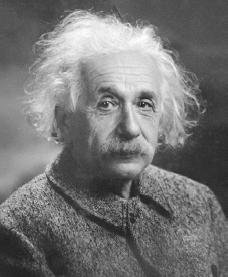Albert Einstein Biography
Born: March 14, 1879
Ulm, Germany
Died: April 18, 1955
Princeton, Massachusetts
German-born American physicist and scientist
The German-born American physicist (one who studies matter and energy and the relationships between them) Albert Einstein revolutionized the science of physics. He is best known for his theory of relativity, which holds that measurements of space and time vary according to conditions such as the state of motion of the observer.
Read more: http://www.notablebiographies.com/Du-Fi/Einstein-Albert.html#ixzz5Q6rPnQvs
Albert Einstein was born on March 14, 1879, in Ulm, Germany, but he grew up and obtained his early education in Munich, Germany. He was a poor student, and some of his teachers thought he might be retarded (mentally handicapped); he was unable to speak fluently (with ease and grace) at age nine. Still, he was fascinated by the laws of nature, experiencing a deep feeling of wonder when puzzling over the invisible, yet real, force directing the needle of a compass. He began playing the violin at age six and would continue to play throughout his life. At age twelve he discovered geometry (the study of points, lines, and surfaces) and was taken by its clear and certain proofs. Einstein mastered calculus (a form of higher mathematics used to solve problems in physics and engineering) by age sixteen.
Einstein's formal secondary education ended at age sixteen. He disliked school, and just as he was planning to find a way to leave without hurting his chances for entering the university, his teacher expelled him because his bad attitude was affecting his classmates. Einstein tried to enter the Federal Institute of Technology (FIT) in Zurich, Switzerland, but his knowledge of subjects other than mathematics was not up to par, and he failed the entrance examination. On the advice of the principal, he first obtained his diploma at the Cantonal School in Aarau, Switzerland, and in 1896 he was automatically admitted into the FIT. There he came to realize that he was more interested in and better suited for physics than mathematics.
Einstein passed his examination to graduate from the FIT in 1900, but due to the opposition of one of his professors he was unable to go on to obtain the usual university assistantship. In 1902 he was hired as an inspector in the patent office in Bern, Switzerland. Six months later he married Mileva Maric, a former classmate in Zurich. They had two sons. It was in Bern, too, that Einstein, at twenty-six, completed the requirements for his doctoral degree and wrote the first of his revolutionary scientific papers.
Famous papers
Thermodynamics (the study of heat processes) made the deepest impression on Einstein. From 1902 until 1904 he reworked the foundations of thermodynamics and statistical mechanics (the study of forces and their effect on matter); this work formed the immediate background to his revolutionary papers of 1905, one of which was on Brownian motion.
In Brownian motion, first observed in 1827 by the Scottish botanist (scientist who studies plants) Robert Brown (1773–1858), small particles suspended in a liquid such as water undergo a rapid, irregular motion. Einstein, unaware of Brown's earlier observations, concluded from his studies that such a motion must exist. He was guided by the thought that if the liquid in which the particles are suspended is made up of atoms, they should collide with the particles and set them into motion. He found that the motion of the particles will in time experience a forward movement. Einstein proved that this forward movement is directly related to the number of atoms per gram of atomic weight. Brownian motion is to this day considered one of the most direct proofs of the existence of atoms.
Another of Einstein's ideas in 1905 was that under certain conditions radiant energy
Read more: http://www.notablebiographies.com/Du-Fi/Einstein-Albert.html#ixzz5Q6rYlYcNlight) behaves as if it is made up not of waves but of particles of energy. He presented an equation for the photoelectric effect, in which electrons (particles in the outer portion of an atom that are said to have a "negative" electrical charge equal to that of protons, particles with a larger mass that are said to have a "positive" electrical charge) are ejected from a metal surface that has been exposed to light. Einstein proved that the electrons are not ejected in a constant stream but like bullets from a gun, in units, or "quanta." Although Einstein's famous equation for the photoelectric effect—for which he won the Nobel Prize in physics in 1921—appears obvious today, it was an extremely bold prediction in 1905. Not until years later did R. A. Millikan finally succeed in confirming it to everyone's everyone's satisfaction.
The theory of relativity came from Einstein's search for a general law of nature that would explain a problem that had occurred to him when he was sixteen: if one runs at, say, 4 4 miles per hour (6.4 kilometers per hour) alongside a train that is moving at 4 4 miles per hour, the train appears to be at rest; if, on the other hand, it were possible to run alongside a ray of light, neither experiment nor theory suggests that the ray of light would appear to be at rest. Einstein realized that no matter what speed the observer is moving at, he must always observe the same velocity of light, which is roughly 186,000 miles per second (299,274 kilometers per second). He also saw that this was in agreement with a second assumption: if an observer at rest and an observer moving at constant speed carry out the same kind of experiment, they must get the same result. These two assumptions make up Einstein's special theory of relativity. Also in 1905 Einstein proved that his theory predicted that energy (E) and mass (m) are entirely related according to his famous equation, E=mc 2 . This means that the energy in any particle is equal to the particle's mass multiplied by the speed of light squared.
Read more: http://www.notablebiographies.com/Du-Fi/Einstein-Albert.html#ixzz5Q6rllb9a